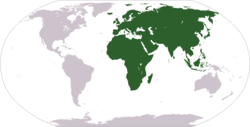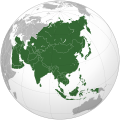| Area | 85,135,000 km2 (32,871,000 sq mi) |
|---|---|
| Population | 6.7 billion (2019) |
| Population density | 78.7/km2 (204.2/sq mi) |
| Demonym | Afro-Eurasian, Afroeurasian, Eurafrasian |
| Countries | 146 countries 8 de facto states |
| Dependencies | 11 dependencies 5 territories |
| Time zones | UTC−01:00 – UTC+12:00 |
| Part of | Earth |
Afro-Eurasia (also Afroeurasia and Eurafrasia) is a supercontinent comprising the continents of Africa, Asia, and Europe. [1] [2] The terms are compound words of the names of its constituent parts. Afro-Eurasia has also been called the "Old World", in contrast to the "New World" referring to the Americas.
Contents
- Related terms
- Geology
- Past
- Present
- Future
- Extreme points
- Mainland
- Including islands
- Elevation
- See also
- Subregional groupings
- References
- External links
Afro-Eurasia encompasses 85,135,000 km2 (32,871,000 sq mi), 57% of the world's land area, and has a population of approximately 6.7 billion people, roughly 86% of the world population. Together with mainland Australia, they comprise the vast majority of the land in the world's Eastern Hemisphere. The Afro-Eurasian mainland is the largest and most populous contiguous landmass on Earth.













